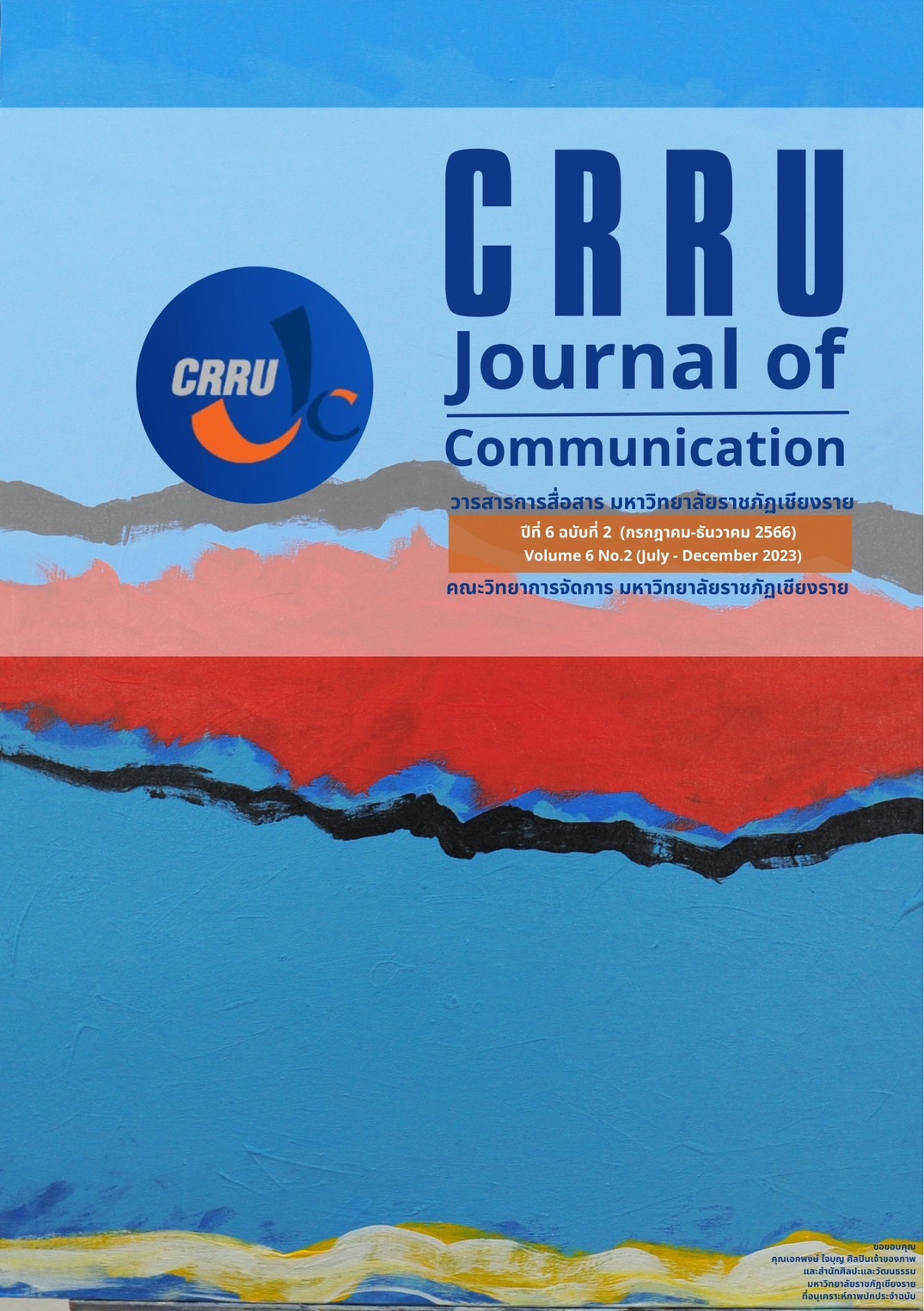Developing a Marketing Model for Rebranding Suan Ban Kaew Palace, Chanthaburi
Main Article Content
Abstract
The research project titled "Developing a Marketing Model for Rebranding Suan Ban Kaew Palace" aims to (1) analyze the perceptions of Generation Z travelers regarding the marketing mix factors of services at Suan Ban Kaew Palace in Chanthaburi Province, (2)
analyze the expectations of Generation Z travelers regarding the 7Ps marketing mix factors of services at Suan Ban Kaew Palace in Chanthaburi Province, and (3) synthesize and create a marketing model for rebranding Suan Ban Kaew Palace. To achieve these objectives, a qualitative research methodology was employed, utilizing observation, documentary research, interviews, and focus group discussions to collect data from various sources. These sources included 50 Generation Z travelers with direct and indirect experience at Suan Ban Kaew Palace and 15 staff members of Suan Ban Kaew Palace, as well as print and web-based materials and object-based data sources. The data collection period was from July 2021 to March 2022, spanning 9 months.
Preliminary findings related to the perceptions and expectations of Generation Z travelers regarding the marketing mix factors at Suan Ban Kaew Palace will be used as input for brainstorming sessions with experts and stakeholders involved in the rebranding of Suan Ban Kaew Palace, such as external marketing experts, palace officials, community culture and development officers, and other relevant groups. Finally, the conclusions from the brainstorming sessions will be analyzed using grounded theory methodology to create a marketing model for rebranding Suan Ban Kaew Palace.
The research findings indicate that the marketing mix factors to be considered in rebranding Suan Ban Kaew Palace include 7 factors: (1) Paradigm Factor: shifting from an extreme conservative paradigm to a contemporary conservative paradigm, (2) Management Factor: transitioning from government administration to a social enterprise model, (3) Market Segmentation Factor: expanding the market segment to include Generation Z travelers, particularly targeting students of Rambhai Barni Rajabhat University, (4) Product Line Factor:
diversifying other services and digital asset products from Suan Ban Kaew Palace's capital, (5) Integrated Marketing Communication and Brand Factor: implementing integrated marketing communication across all offline and online channels to create touchpoints along the Generation Z travelers' journey, (6) Digital Lifestyle Factor: developing the "Suan Ban Kaew Lifestyle" on a mobile application, and (7) Research and Development Factor: evaluating business trends and traveler behaviors.
Article Details
References
คมกริช ทิพยประเสริฐ และคณะ. (2559). โปรแกรมประยุกต์บนอุปกรณ์เคลื่อนที่สำหรับการท่องเที่ยววังสวนบ้านแก้ว. รายงานสืบเนื่องจากการประชุมวิชาการระดับชาติ ด้านคอมพิวเตอร์และเทคโนโลยีสารสนเทศ ครั้งที่ 12 (NCCIT2016). กรุงเทพมหานคร. มหาวิทยาลัยเทคโนโลยีพระจอมเกล้าพระนครเหนือ.
พัชรพร เฟื่องคอน. (2557). การรีแบรนด์ดิ้งและการตอบสนองของผู้บริโภคต่อภาพลักษณ์ตราสินค้าร้านอาหารประเภทปิ้งย่าง. (วิทยานิพนธ์ศิลปศาสตรมหาบัณฑิต). สถาบันบัณฑิตพัฒนบริหารศาสตร์. กรุงเทพมหานคร.
ภูวดล บัวบางพลู และคณะ. (2561). การพัฒนาสื่อเทคโนโลยีความจริงเสมือนเพื่อส่งเสริมการท่องเที่ยว วังสวนบ้านแก้ว มหาวิทยาลัยราชภัฏรำไพพรรณี. จันทบุรี: สำนักวิทยบริการและเทคโนโลยีสารสนเทศ มหาวิทยาลัยราชภัฏรำไพพรรณี.
รวีวรรณ โปรยรุ่งโรจน์. (2558). พฤติกรรมนักท่องเที่ยว. กรุงเทพมหานคร: โอ.เอส. พริ้นติ้ง เฮ้าส์.
วิชาญ ทุมทอง และ ณัฐกาญจน์ พึ่งเกิด. (2558). ระบบพิพิธภัณฑ์อัจฉริยะโดยใช้เทคโนโลยีบีค่อน กรณีศึกษาวังสวนบ้านแก้ว. จันทบุรี: คณะวิทยาการคอมพิวเตอร์และเทคโนโลยีสารสนเทศ มหาวิทยาลัยราชภัฏรำไพพรรณี. จันทบุรี.
สิริวิภา วิมุกตายน, ฐปนีย์ ศรีแก้ว และ ปฏิวัติ สุริโย. (2561). การศึกษาอัตลักษณ์วังสวนบ้านแก้วเพื่อพัฒนาของที่ระลึกสำหรับส่งเสริมการท่องเที่ยว. ใน สถาบันวิจัยและพัฒนา (บ.ก.), รายงานสืบเนื่องจากการประชุมวิชาการระดับชาติ วิจัยรำไพพรรณี ครั้งที่ 12. . จันทบุรี. สถาบันวิจัยและพัฒนา มหาวิทยาลัยราชภัฏรำไพพรรณี.
สำนักศิลปวัฒนธรรมและพัฒนาชุมชน มหาวิทยาลัยราชภัฏรำไพพรรณี. (2564). ทิศทางการดำเนินงานการตลาดท่องเที่ยววังสวนบ้านแก้ว. การจัดประชุมระดมความคิดสร้างสรรค์. จันทบุรี. สำนักศิลปวัฒนธรรมและพัฒนาชุมชน มหาวิทยาลัยราชภัฏรำไพพรรณี.
อภิวรรณ ศิรินันทนา. (2560). การศึกษารูปแบบการประชาสัมพันธ์การท่องเที่ยวของวังสวนบ้านแก้ว. จันทบุรี: คณะนิเทศศาสตร์ มหาวิทยาลัยราชภัฏรำไพพรรณี.
ศูนย์บริการวิชาการแห่งจุฬาลงกรณ์มหาวิทยาลัย. (2561). รู้จักจุฬา. สืบค้นจากhttps://www.chula.ac.th/about/overview/introduction-to-chula/
World Tourism Organization. (1995). ความหมายของการท่องเที่ยว. Retrived from https://tourismatbuu.wordpress.com/
Kotler, P. (2010). Marketing 3.0. New Jersey: Hoboken.
_______. (2017). Marketing 4.0. New Jersey: Hoboken.
_______. (2021). Marketing 5.0. New Jersey: Hoboken.


